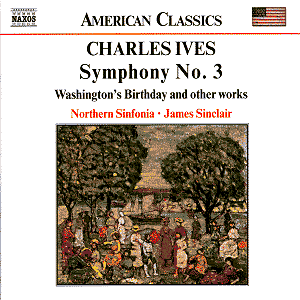One of my rules of thumb for listening to, and enjoying
the music of Charles Ives is to try not to play 'spot the tune.' If
we fall into the trap of seeing this music as some kind of arrangement
or transcription of hymn tunes or circus marches we will tend to miss
much of its intellectual depth and sheer musicality. To be fair, Ives
uses a number of such tunes in his Third Symphony - including 'What
a Friend we have in Jesus' and 'Oh for a Thousand Tongues.' Yet these
are a vehicle for expressing the inexpressible. This music is not primitive.
It is not, I believe, even meant to be sentimental or full of pathos.
All this is not to say that we should not enjoy a tune simply because
it is or has been popular. Of course there will always be sentimental
baggage with many of these musical quotations. It is simply that we
must not allow an apparent banality to spoil our enjoyment of this excellent
music.
The programme notes of this fine CD suggest that there
is a 'programme' to Third Symphony. Now I do agree that this is superficially
correct. Each of the three movements carries a subtitle:- Old Folks
Gatherin'; Children’s Day and Communion. The very title of
the Symphony is 'The Camp Meeting'. Yet I believe that what this
symphony is actually doing is recreating spiritually and not pictorially
the emotions engendered by the old time religion that Ives knew as a
boy. It is not an attempt at painting a musical picture; it is not an
attempt at preserving a number of well-known tunes. This work is perhaps
the most subtle and introspective of the composer’s symphonic cycle.
It was completed in 1904 but was not premiered until 1946. I enjoyed
this recording by the Northern Sinfonia and appreciated the intimate
almost chamber music qualities of the playing.
The Holidays Symphony is actually a collection
of four somewhat disparate works that hold together simply by being
musical evocation of American holidays. One movement is given here:
Washington's Birthday. This stands very well on its own and impresses
with its sharp contrast between winter night atmospherics and a barn
dance complete with Jew’s harp.
This may not be great music but it certainly inhabits
a unique sound world.
Perhaps Ives’ most famous and popular (if that is the
correct word to use) work is 'The Unanswered Question.' This
piece was paired with 'Central Park in the Dark,' and was given
the overall title of 'Two Contemplations.' The Unanswered
Question has a number of alternative titles and these perhaps give
some clues to the work's meaning. These include 'a Cosmic Landscape,'
a 'Contemplation of a Serious Matter' and 'The Unanswered Serious Question.'
It was composed around 1906 but was subject to a number of revisions
in the 1930s. It is written very much in the style of a collage; one
piece of music being piled on top of another. Constant contrast of styles
and a throwing together of disparate themes are what makes this work
tick. It is all about 'cosmic drama’. We have here the silence of the
Druids, the perennial question of existence and a number of attempts
at an answer. This was music that was well ahead of its time. It took
other avant-garde composers more than half a century to catch up. Yet
to us this music is elemental; it is near perfect in its balance of
sounds, structures and noise.
Central Park in the Dark is less demanding on
our cosmological and philosophical understandings. It is quite simply
an evocation of the moods and emotions engendered by a night-time view
of Manhattan in the last decade of the Nineteenth Century. We are reminded
of trains, popular songs, pianolas, ragtime and even a runaway horse
- apparently. However the work is framed on either side by brooding
string music summing up the darkness of the park against the bright
lights of the city streets. The listener begins in the park, emerges
into the city and retreats to the park. It is Yankee impressionism at
its very best.
The Country Band March is pure fun. All
the Ivesian characteristics are present: the well known tunes, two melodies
playing at once and exuberant orchestration. Here the composer manages
to glory in humouring the wrong notes of the players and the falling
apart of the rhythmic momentum. Altogether an excellent piece to introduce
the neophyte to this great American Composer.
The Overture and March '1776' is less well known.
However it is really quite a classic. It was originally conceived as
an overture to an opera about the 'revolutionary era'. It is very much
a parody of the 'slow' march' and allows the composer to quote a number
of well-known tunes, including the La Marseillaise. The quieter
and slower parts of this work are actually quite profound.
Taken in the round, this is an excellent introduction
to the orchestral music of Charles Ives. It explores quite a wide range
of emotion; from the spirituality of old time religion at its best through
to the festivities of Washington's Birthday and the strains of a country
band playing at some local event. Here are all the Ives fingerprints
presented in the space of a single CD. I am a bit disappointed that
this otherwise great CD is so short on material. There is less than
50 minutes of music! Bad form for Naxos, I am afraid. However, the sound
recording is good and the playing enthusiastic.
John France
